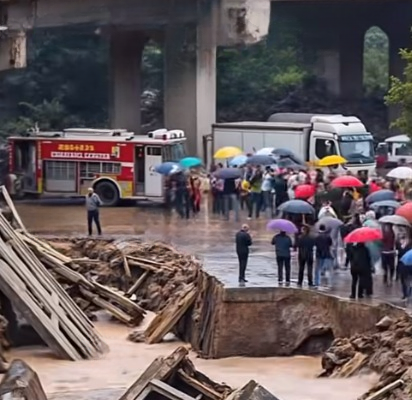🚨BREAKING NEWS🚨Just hours ago,Urgent: 7.7 Earthquake

In the calm hours of early morning, while most families were still resting, the ground beneath communities in Southeast Asia unexpectedly trembled with extraordinary force. Within moments, silence turned to confusion as the earth shook violently. Entire neighborhoods felt the shock almost simultaneously.
What began as faint vibrations quickly grew into intense movements that rattled buildings, toppled household items, and sent residents rushing outdoors in fear. Streets filled with people holding children, guiding elderly relatives, or simply standing in disbelief at what was unfolding. Walls cracked, windows shattered, and roofs collapsed under the pressure of nature’s raw energy.
This was not a minor tremor. On Monday morning, a 7.7-magnitude earthquake struck the border region between China and Myanmar, spreading its force into neighboring countries. According to scientific assessments from the U.S. Geological Survey (USGS), the quake originated at a depth of only 10 kilometers beneath the surface—shallow enough to magnify its destructive effect.
The Regions Impacted
The quake’s reach extended well beyond its epicenter. It was felt across:
-
Southern China, particularly in Yunnan Province.
-
Myanmar, where many towns near the epicenter saw entire rows of older homes collapse.
-
Northern Thailand, with reports from cities like Chiang Rai and Chiang Mai describing swaying buildings.
-
Even Bangkok, more than 700 kilometers away, where some residents noticed light tremors.
This broad impact highlights just how powerful the seismic event was and why its aftermath is so complex.
Human Toll and Structural Damage
In the first hours following the quake, reports emerged of collapsed schools, damaged bridges, and fractured highways. Dozens of lives were confirmed lost shortly after the disaster, and the number of injuries quickly grew into the hundreds. Many people were hurt by falling debris or trapped beneath collapsed buildings.
In Myanmar, where many buildings lack modern earthquake-resistant features, damage was particularly severe. In rural areas close to the epicenter, communication lines were cut, leaving entire communities isolated from the outside world. Thousands of people were displaced, many forced to spend the night in open spaces or makeshift shelters.
Meanwhile, in Yunnan Province of China, hospitals quickly filled with injured survivors. Medical teams reported treating fractures, head injuries, and trauma caused by collapsed structures. Volunteers and community members joined rescue teams in transporting the wounded.
Tremors Across Borders
One of the most remarkable features of this earthquake was its range. In northern Thailand, office workers and students evacuated buildings and gathered in parking lots, too anxious to return indoors. In Myanmar, residents described the ground “rolling like ocean waves,” leaving deep cracks in roads and rice fields.
Sacred sites were not spared. Several ancient temples and pagodas sustained visible damage, some of them centuries old. For many residents, the sight of cultural landmarks collapsing was as painful as the destruction of their homes.
Emergency Response in Action
Despite blocked roads, damaged communication towers, and widespread blackouts, emergency services mobilized rapidly. Teams equipped with rescue dogs, cranes, and specialized tools were deployed to towns closest to the epicenter. Local governments set up temporary shelters in schools and sports facilities, offering residents food, water, and blankets.
The Red Cross and Red Crescent Societies pledged immediate assistance, preparing to send tents, medical kits, and other critical supplies. Volunteers across affected countries began donation drives to support survivors.
Still, challenges remain immense. Damaged infrastructure has slowed the delivery of aid. Entire mountain villages remain cut off due to landslides, and some rescue workers are traveling by foot to reach them.
Stories of Courage and Survival
Even in the midst of destruction, inspiring stories are emerging.
-
In one Chinese village, a family of five was found alive after hours trapped beneath rubble. Neighbors dug with bare hands until professional rescuers arrived.
-
In Myanmar, a schoolteacher shielded her students when their classroom ceiling began to collapse, suffering injuries herself but saving dozens of children.
-
Volunteers in Thailand opened their homes to strangers stranded by transportation shutdowns, showing regional solidarity.
Such stories demonstrate that resilience and compassion often shine brightest in the darkest times.
Why This Earthquake Was So Destructive
Experts note that the shallow depth of the quake—just 10 kilometers—played a crucial role in the damage. Shallow quakes release their energy almost directly at the surface, leaving little chance for the shockwaves to weaken before reaching communities.
The China–Myanmar border lies along a tectonic collision zone where the Indian Plate presses into the Eurasian Plate. This geological interaction has historically produced destructive earthquakes. Past events in nearby regions, such as the 2011 Yunnan earthquake and the 2015 Nepal quake, share similar causes.
Seismologists stress that the combination of shallow depth, densely populated areas, and vulnerable infrastructure magnified the impact of this disaster.
Challenges for Rescue Teams
Rescue workers are racing against time. Landslides triggered by the quake have blocked vital routes, preventing heavy machinery from reaching remote areas. Communication breakdowns in villages make coordination difficult, forcing rescuers to depend on local guides.
Hospitals are overwhelmed, with some doctors working nonstop for over 24 hours. Field hospitals are being set up to handle the overflow of patients. Aftershocks measuring above magnitude 5 have already been recorded, endangering rescuers who must operate around unstable debris.
The risks are significant: a single aftershock could cause already weakened buildings to collapse completely.
International and Regional Support
The scale of the disaster has drawn attention worldwide. Neighboring countries, including Thailand and India, have offered logistical help, while international organizations have begun coordinating aid shipments. The United Nations Office for the Coordination of Humanitarian Affairs (OCHA) is monitoring developments closely.
Experts note that the first 72 hours after such a disaster are the most critical. This is the window during which trapped survivors are most likely to be rescued alive. Beyond that, efforts shift toward recovery, rebuilding, and providing long-term support to survivors.
Essential needs—clean water, food, and medical care—are already scarce in several regions. Aid groups are prioritizing these supplies alongside shelter materials such as tents and tarpaulins.
The Human Side of the Tragedy
Statistics cannot capture the deep personal losses caused by this event. Families have been separated, children left orphaned, and elderly residents forced from homes they had lived in for decades. In shelters, parents search desperately for missing relatives while others grieve openly.
Mental health professionals warn that the emotional effects of such disasters can last far beyond the initial crisis. Children, in particular, may carry trauma into adulthood if not provided with counseling and support. Recovery, therefore, is not just about rebuilding structures but also about healing people.
Learning from Past Disasters
This earthquake recalls earlier tragedies in the region. The 2008 Sichuan earthquake in China resulted in nearly 90,000 deaths, while the 2015 Nepal earthquake killed almost 9,000 people. Both highlighted how inadequate construction and lack of preparedness can worsen the toll of natural disasters.
China has updated its building codes in recent years, but enforcement is uneven, especially in rural areas. Myanmar, facing economic challenges, struggles even more to enforce resilient construction standards. Experts stress that investments in earthquake-resistant design, early warning systems, and disaster education programs are essential to reduce future risks.
Moving Forward: Recovery and Reconstruction
While rescue operations remain the immediate priority, governments and aid organizations are already planning the longer-term task of rebuilding. Priorities include:
-
Restoring electricity, water, and communication systems.
-
Providing housing for tens of thousands who lost homes.
-
Reconstructing schools and hospitals to meet higher safety standards.
-
Offering ongoing psychological care to survivors, especially children.
International donors are expected to play a significant role, particularly in Myanmar. The rebuilding phase is not only about replacing what was lost but also about creating stronger, safer communities prepared for future disasters.
Conclusion: A Region Tested but Not Broken
The 7.7-magnitude earthquake along the China–Myanmar border has left deep scars across multiple nations. Lives have been lost, infrastructure damaged, and entire communities displaced. Yet amid this devastation, countless examples of bravery, solidarity, and human resilience shine through.
The days ahead will be decisive. Rescue teams continue to work tirelessly, humanitarian groups are mobilizing, and international cooperation is strengthening. While recovery will take years, the determination of affected communities to rebuild offers hope for the future.
This event reminds us of the urgent need for preparedness in earthquake-prone regions, investment in resilient infrastructure, and compassion that transcends national borders. Natural disasters may be unavoidable, but collective strength can turn tragedy into an opportunity for renewal.



